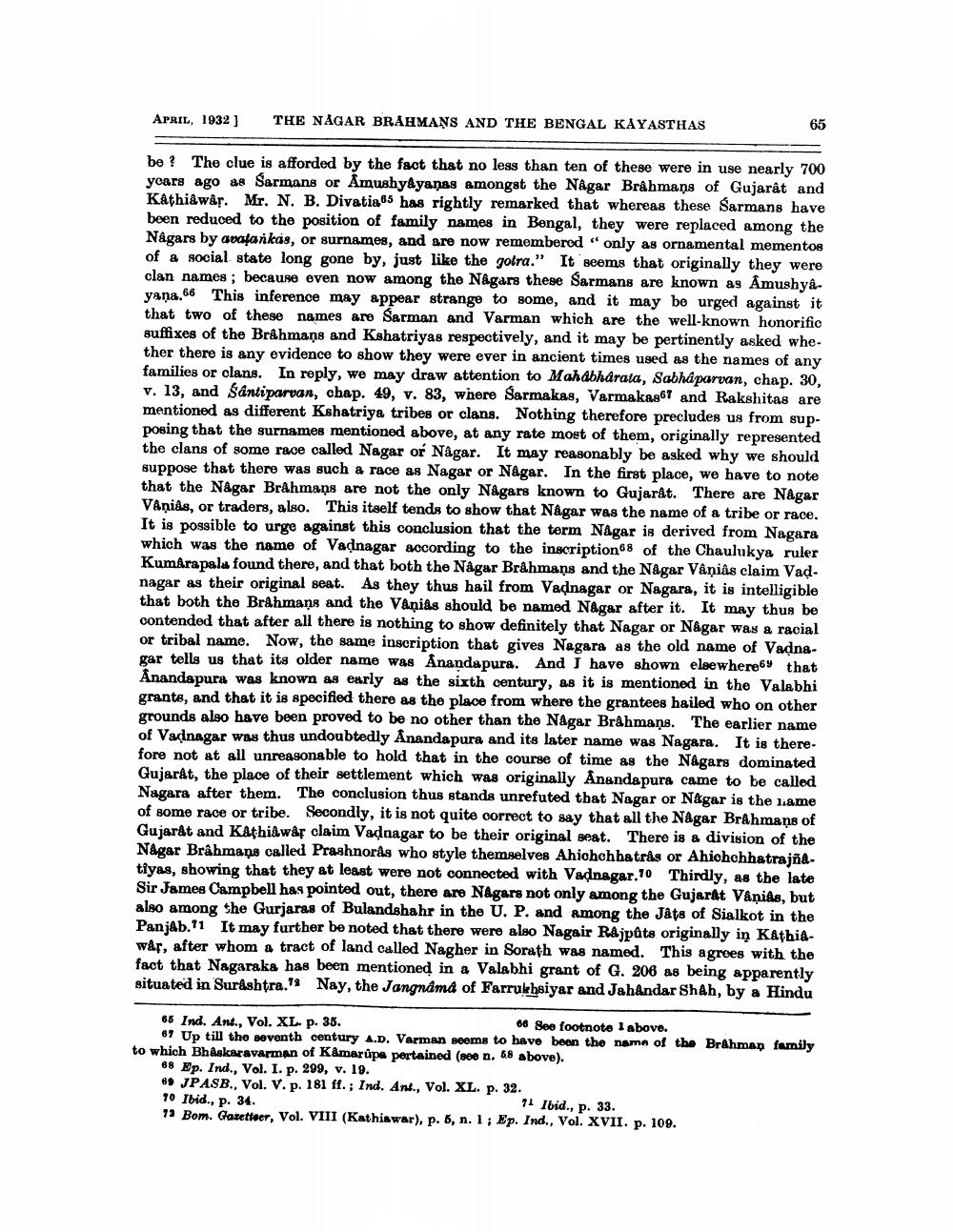________________
APRIL, 1932)
THE NÅGAR BRAHMAŅS AND THE BENGAL KAYASTHAS
65
be? The clue is afforded by the fact that no less than ten of these were in use nearly 700 years ago as Sarmans or Amushyâyanas amongst the Nagar Brahmans of Gujarat and Kathiâwâr. Mr. N. B. Divatia 65 has rightly remarked that whereas these Sarmans have been reduced to the position of family names in Bengal, they were replaced among the Någars by avatarkas, or surnames, and are now rememberod "only as ornamental mementos of a social state long gone by, just like the golra.” It seems that originally they were clan names; because oven now among the Nagars these Sarmans are known as Amushyayana.66 This inference may appear strange to some, and it may be urged against it that two of these names are Sarman and Varman which are the well-known honorific suffixes of the Brahmans and Kshatriyas respectively, and it may be pertinently asked whether there is any evidence to show they were ever in ancient times used as the names of any families or clans. In reply, we may draw attention to Mahabharata, Sabha parvan, chap. 30, v. 13, and Santiparvan, chap. 49, v. 83, where Sarmakas, Varmakas67 and Rakshitas are mentioned as different Kshatriya tribes or clans. Nothing therefore precludes us from supposing that the surnames mentioned above, at any rate moet of them, originally represented the clans of some race called Nagar or Någar. It may reasonably be asked why we should suppose that there was such a race as Nagar or Nagar. In the first place, we have to note that the Nagar Brahmans are not the only Nagars known to Gujarat. There are Nagar VAniás, or traders, also. This itself tends to show that Nagar was the name of a tribe or race. It is possible to urge against this conclusion that the term Nagar is derived from Nagara which was the name of Vadnagar aocording to the inscription of the Chaulukya ruler KumArapala found there, and that both the Nagar Brahmans and the Någar Våņiâs claim Vad. nagar as their original seat. As they thus hail from Vadnagar or Nagara, it is intelligible that both the Brahmans and the Vanias should be named Nagar after it. It may thus be contended that after all there is nothing to show definitely that Nagar or Nagar was a racial or tribal name. Now, the same inscription that gives Nagara as the old name of Vadnagar tells us that its older name was Anandapura. And I have shown elsewhere69 that Anandapura was known as early as the sixth century, as it is mentioned in the Valabhi grants, and that it is specified there as the place from where the grantees hailed who on other grounds also have been proved to be no other than the Någar Bråhmans. The earlier name of Vainagar was thus undoubtedly Anandapura and its later name was Nagara. It is there. fore not at all unreasonable to hold that in the course of time as the Nagars dominated Guiarát. the place of their settlement which was originally Anandapura came to be called Nagara after them. The conclusion thus stands unrefuted that Nagar or Någar is the name of some race or tribe. Secondly, it is not quite correct to say that all the Nagar Brahmans of Gujarat and Kathidwar claim Vadnagar to be their original soat. There is & division of the Någar Brahmans called Prashnorås who style themselves Ahichchhatras or Ahichchhatrajña. tiyas, showing that they at least were not connected with Vadnagar. Thirdly, as the late Sir James Campbell has pointed out, there are Någars not only among the Gujarat Vånies, but also among the Gurjaras of Bulandshahr in the U. P. and among the Jåts of Sialkot in the PanjAb. 11 It may further be noted that there were also Nagair Rajpâte originally in Kathidwår, after whom a tract of land called Nagher in Sorath was named. This agrees with the fact that Nagaraka has been mentioned in a Valabhi grant of G. 206 as being apparently situated in Surashtra." Nay, the Jangnamd of Farrukhsiyar and Jahåndar Shah, by a Hindu
65 Ind. Ant., Vol. XL- p. 35.
66 See footnoto 1 above. 67 Up till the seventh century A.D. Varman seems to have been the name of the BrAhman family to which Bhaskaravarman of Kåmarûpe pertained (see n. 68 above).
88 Ep. Ind., Vol. I. p. 299, v. 19. 69 JPASB., Vol. V. p. 181 ff.; Ind. Ant., Vol. XL. p. 32. 10 Ibid., p. 34.
71 Ibid., p. 33. 73 Bom. Gazetteer, Vol. VIII (Kathiawar), p. 6, n. 1; Ep. Ind., Vol. XVII. p. 109.




